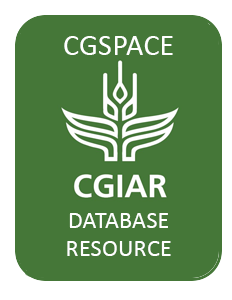Maize is a critical staple cereal across Sub-Saharan Africa but attempts to improve its productivity in small-scale farming systems often prove disappointing. The 12 key technologies required to overcome poor yields are mostly known, but the manner that they are mobilized, packaged, and…
The source of data used to estimate the e-flow requirement in Sustainable Development Goal (SDG) Indicator 6.4.2 (level of water stress: freshwater withdrawal as a proportion of available freshwater resources) is the Global Environmental Flow Information System (GEFIS), an online tool produced…
The evaluation function of the Independent Advisory and Evaluation Services (IAES), is executing the 2024 evaluations of the three Science Groups (SGs)—Systems Transformation (ST), Resilient Agrifood Systems (RAFS), and Genetic Innovation (GI). The evaluation Terms of Reference (TORs), which…
The objective of this research was to determine the effect of cassava (Manihot esculenta Crantz) supplementation on enteric methane (CH4) emissions, carbon footprint, and production parameters in dairy cows. Daily concentrate supply for Jersey and Jersey * Holstein breeds was evaluated in four…
Cassava breeding faces obstacles due to late flowering and poor flower and seed set. The acceleration of breeding processes and the reduction in each cycle’s duration hinge upon efficiently conducting crosses to yield ample progeny for subsequent cycles. Our primary objective was to identify…
Participatory approaches for crop variety testing can help breeding teams to incorporate traditional knowledge and consider site-specific sociocultural complexities. However, traditional participatory approaches have drawbacks and are seldom streamlined or scaled. Decentralized on-farm testing…
In the context of climate change, high temperature is one of the main abiotic stresses hampering durum wheat production. Through the characterization of an international panel of 271 genotypes, this study investigates the effects of heat stress on quality traits and identifies which glutenins (…
Durum wheat is a staple food of the Mediterranean Basin, mostly cultivated under rainfed conditions. As such, the crop is often exposed to moisture stress. Therefore, the identification of genetic factors controlling the capacity of genotypes to convert moisture into grain yield (i.e., water…
Matching crop varieties to their target use context and user preferences is a challenge faced by many plant breeding programs serving smallholder agriculture. Numerous participatory approaches proposed by CGIAR and other research teams over the last four decades have attempted to capture…
Infrastructure in river basins is essential to achieving several Sustainable Development Goals (SDGs), including SDG 2 on zero hunger, SDG 6 on water and sanitation, and SDG 7 on affordable and clean energy. However, important tradeoffs and synergies need to be navigated across these goals as…
Solar-powered groundwater irrigation is expanding exponentially in low- and middle-income countries (LMICs), creating opportunities and risks. In South Asia, more than 500,000 small stand-alone pumps have already been installed (see the figure). In Sub-Saharan Africa, solar pumps are gaining…
Sustainable land management (SLM) entails the judicious use of land resources, incorporating soils, water, animals, and plants, to meet dynamic human needs, while concurrently safeguarding the sustained use of these resources and preserving their environmental functions. SLM serves as a guiding…

